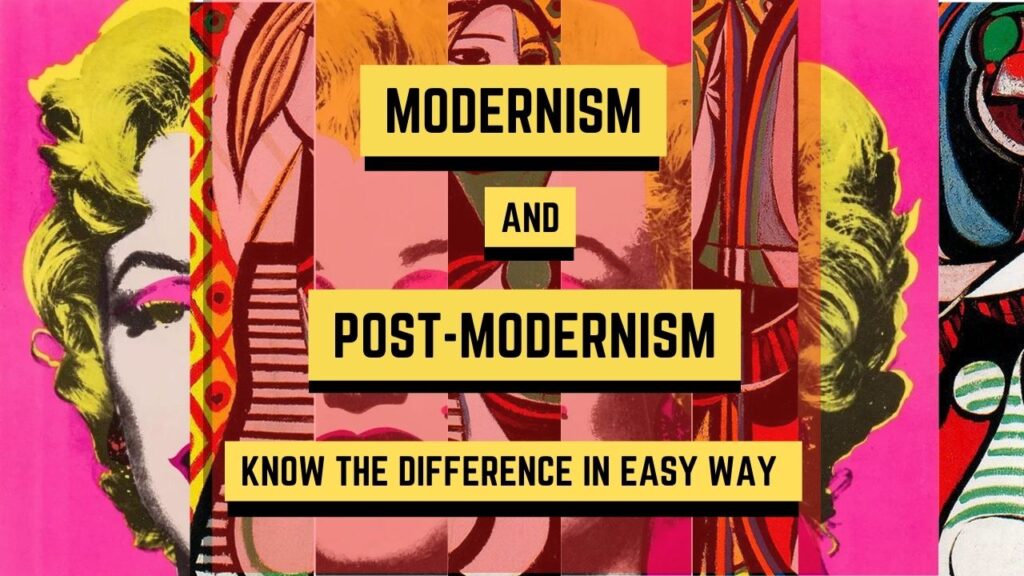Have you read a book that made you feel understood? And then you wonder how could a piece of written text relate to you so much. But that is exactly the purpose of literature. It not only mirrors individual problems but also the society of its time. This is why reading Charles Dickens would give you an apt understanding of the 19th century. Be it culture, political ideas, or societal systems, all are well captured by the literary works of that century. These works are categorized under various literary periods with each echoing the society of their time. Old English Period, Renaissance age, to the present post-modern age, these are some of the literary periods. We in this blog will touch upon differences between Modernism and Post-Modernism ages. From different founding philosophies to varying characteristic features, all are covered below. So, check these modernism vs post-modernism differences out below!
1. Time frame and cause of Its Birth vary
The transition from one to the other period happens just within a century. While Modernism spans from the 1860s to the beginning of World War II, Post-Modernism began after World War II. But how did these movements begin? Politically speaking, the groundwork for the movement began way before it started. With British Empire’s control over the world slipping away, rapid industrialization, and the introduction of philosophies that challenged the beliefs of the world, doubt, anxiety, etc. began to permeate into people. But WWI became the driving force for Modernism to come into full effect. The bloodshed, disruption of structure, huge economic loss, etc. propelled them to the edge of chaos and made them rethink a new way for society and individuals to function. Which is when the Age of Modernism came in.
It’s noteworthy to mention here, that Modernism began as a movement for visual arts where artists invented different techniques such as surrealism, expressionism, cubism, etc. to encapsulate the world. Hub for such techniques was Europe, mainly France. From there it swept all over the world, once writers started practicing the visual art principles in literature. On the other hand, Post-Modernism came into prominence after World War II, as a result of destruction in the war, especially the bombing of Hiroshima and Nagasaki by the US as well as the Holocaust. More than that, it was a reaction against Modernist principles and beliefs. While the two wars caused widespread destruction, the way both these periods approach the consequences of war differs a lot, which is why drawing a line between both becomes extremely important. Although the lines may seem blurry for the core of their origin is the two World Wars.
2. Core philosophies influencing the movements are different
Scientific, psychological, sociological and many other new philosophies challenged existing beliefs. Such as Charles Darwin’s theorization of the evolution of man from apes raised suspicions towards the religious beliefs. Similarly, Marx’s social class theory arouses skepticism towards the existing social divisions. People rid with doubts, and no system of religion, society, etc. to rely on became more anxious. The outbreak of World War I broke all barriers and hopelessness, anxiety, chaos took the form of Modernism. In this Age, all known ideas were no more relevant. So newer theories of Sigmund Freud such as uncovering unconscious recesses of the human mind and Henri Bergson’s relative experiencing of time, influenced the way people perceived the world or searched for a singular structure to rely on. These also influenced writers to turn from objective realities to subjective interpretations of reality and time which led to new stylistic techniques and methods.
On the other hand, Post-Modernism faced the same disruption which was reflected in the works as well. But more than Freud and Bergson, other philosophies shaped the works of the age. Here, the philosophy of Lyotard which undermined the significance of grand narratives or totalizing explanations of phenomena and made way for micro-narratives or multiple narratives to account for a single experience with none of the narratives being wrong became significant. Similar to this, Jacques Derrida’s deconstructionist work proved language as being subjective to interpretation or devoid of any self-contained meaning. This allows multiple interpretations to follow out of a single experience which became an inspiration for stylistic techniques used by many writers of this age. All these philosophies set the tone for these ages and the resulting distinctive features as well.
3. Different approach to chaos In Modernism vs Post-Modernism Eras
Modernism began in the late 19th century but it attained its peak after World War I. Especially, cause of the massive loss of lives and the ensuing chaos. The loss of reliable pillars of society such as science or religion left all feeling hopeless. Anxiety, doubts, alienation, fragmentation, etc. dominated the works of the Modernist period. Writers such as W.B Yeats lamented the loss of order in his famous poem The Second Coming which states “Things fall apart; the centre cannot hold.” Wary of such upcoming anarchy made them feel even more helpless.

But interestingly, Post-Modernists welcomed the chaos with open arms. If there were any hopes of recovery, they perished right after the massacre of World War II. Which is why Post-Modernists not just embraced chaos but also celebrated it. For them, old traditions and social structures did not serve any purpose. So, their demolition could not be counted as a loss. In fact, with earlier systems out of the way, they leveraged the open playground, mix-matching new things and creating new meanings without older principles restricting their paths.
4. Contrasting points of view on the idea of ‘absolute’ truth in Modernism vs Post-Modernism Eras
The notions of ‘absolute truth’ find their beginnings in the Enlightenment period. During this time, religious reforms and scientific progress dominated the world. The latter happened due to man’s scientific reasoning, logical faculties, and thinking capacities. So much so, did this affect the civilization that man came to be known as the highest creature on the planet for it possessed reason. And this reason became the guiding principle for obtaining the universal truths about life. Which meant that knowledge existed in the world independent of man, and he/she alone could access these fundamental ideas of our existence through reason.
But man’s ability to reason and progress hit rock bottom when World War I’s destruction raised questions as to how a man deemed intelligent could cause such widespread destruction. Or in fact, if the man was even intelligent or not. At this point, the ideas of seeking universal truths or objective truths of reality couldn’t sit well with people of the time. They rejected it, especially Modernism which seemed to find newer truths through subjective experiences. Or they lay in existential dread, nostalgic for a structure and feeling lost. Contrary to this, Post-Modernists do not believe in a single existing truth. For them, ‘absolute truths’ are just an illusion and an idea could be both simultaneously true as well as untrue.
5. Varying approach towards individual In Modernism vs Post-Modernism Eras
Age before Modernism tends to depict objective realities of the society. The ills of power, exploitation of the working class, etc. But with the beginnings of the 20th century, an individual started to weigh more than society all due to Freud’s conception of desires of the unconscious mind. Both the ages relied on human perception for understanding the world. Modernism, in particular, expressed this through techniques such as stream of consciousness used by writers like Virginia Woolf.
Such a technique described the inner thoughts and feelings of a character without interruption. And through the eye of character, we see the world around them, getting a subjective experience of reality. But rendering such reality, assumes the existence of a sense of self that is whole, unified, and coherent. Unlike the belief in individuality in the Modern era, we see Post-Modern writers question such a sense of individuality. In fact, they propose the notion of fragmented identity. The “self” as we say is nothing more than a myth for Post-Modernists. And so they avoid using techniques such as stream of consciousness as well.
6. Way meaning gets interpreted from works in Modernism vs Post-Modernism Era Varies
While reading any text, we often find ourselves analyzing the events of the book and its characters too. We interpret their actions, decisions, the causes behind those actions, etc. This interpretation of meaning from Modernist texts is hidden under symbols, images, etc. We need to read those symbols in the context of the whole text to gain their meanings. This means that a writer guides us to find the themes, issues portrayed in the text through the use of symbols.
Quite opposite to this is the case of Post-Modern writers. They don’t write text to convey some deeper hidden meanings. Their focus remains on stating the observable surface-level things. Because of this, the meaning of the text is solely dependent on the reader. They might interpret a dialogue according to what they think it might mean but the writer never gives any clue to its meaning. As a result, a single piece of the book could be interpreted in several ways, all of which will stand true. Such is the case for many works of writers such as Samuel Beckett, Harold Pinter, etc.
7. Use of different stylistic techniques
As with other notions, Modernist writers rejected the stylistic techniques used by literary geniuses in the earlier period. The strict rules of rhyme and meter could not encapsulate the loss and hopelessness of the times. This is where new techniques come in. Symbolism, Imagism, etc. were heavily used in the poetry of the time. Writers such as W.B Yeats, W.H Auden’s, etc. conveyed the concepts with an image, objects, etc, which is called a symbol. For fiction, authors like James Joyce used stream of consciousness.
Surprisingly, Post-Modernism didn’t outright reject the earlier techniques. They deliberately mixed previous styles to create new ones. Some techniques common in their works include pastiche, intertextuality, parody metafiction, etc. All these commented on styles used by previous writers, subverted those styles, referred back to those previous works as well as made readers aware of the nature of fictionality of their work. Dramatists such as Harold Pinter, Edward Bond, etc. use such techniques in their works.
8. Prominent authors and works
Most notable work in Modernism is of T.S Eliot whose name till date acts as a substitute for the age itself. From works such as “The Wasteland” to “The Love Song of J.Alfred Prufrock”, all are great pieces of modern literature. We also have writers such as Ezra Pound, known for his poem “In a Station of the Metro”, Virginia Woolf with her famous novel Mrs. Dalloway, James Joyce with his greatest work “Ulysses” etc. Other great writers include D.H Lawrence known for exploring sexuality in his works such as Sons and Lovers, William Faulkner, W.B Yeats, W.H Audens, etc.
Post-Modernism’s most noteworthy dramatist is Samuel Beckett whose play “Waiting for Godot” was remarkable. Apart from him, Italo Calvino’s “If on a winter’s night a traveler”, Don DeLillo’s “Underworld”, John Fowles “The French Lieutenant’s Woman”, Joseph Heller’s “Catch-22”, Kurt Vonnegut’s “Slaughterhouse-Five” are cherished pieces of postmodernist literature today.
Have more points of difference to add to modernism vs post-modernism list? Comment down below and let us know!



